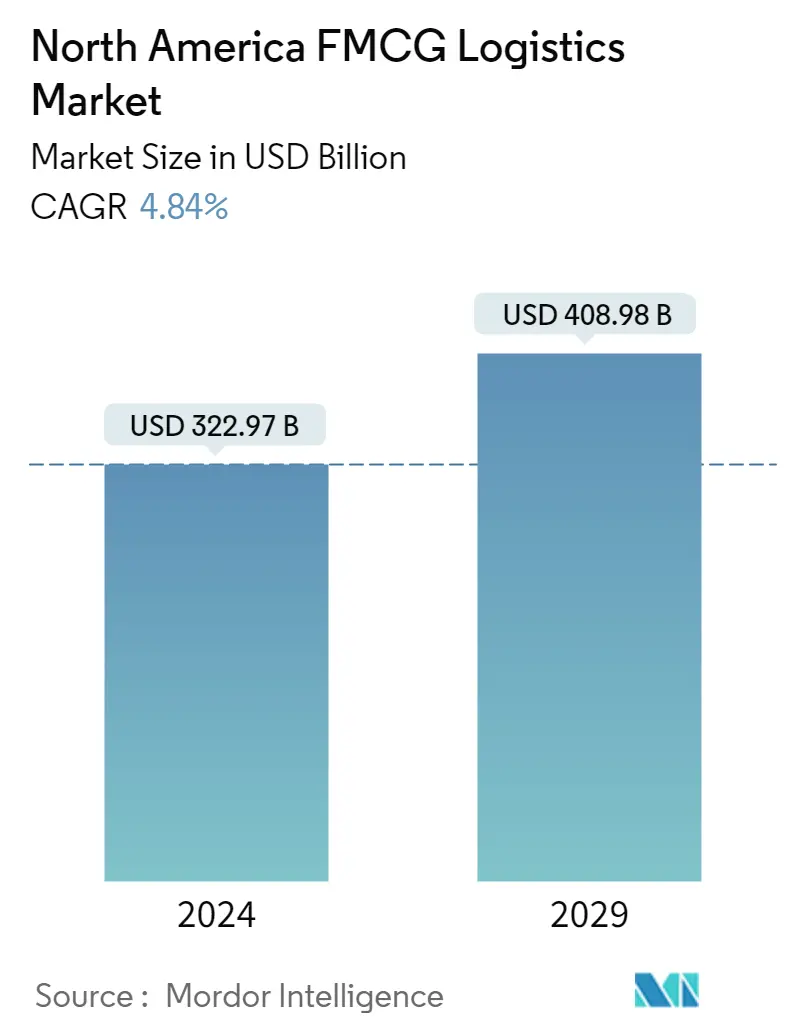Market Size of North America FMCG Logistics Industry

| Study Period | 2019 - 2029 |
| Base Year For Estimation | 2023 |
| Market Size (2024) | USD 322.97 Billion |
| Market Size (2029) | USD 408.98 Billion |
| CAGR (2024 - 2029) | 4.84 % |
| Market Concentration | Low |
Major Players
*Disclaimer: Major Players sorted in no particular order |
North America Fast Moving Consumer Goods (FMCG) Logistics Market Analysis
The North America FMCG Logistics Market size is estimated at USD 322.97 billion in 2024, and is expected to reach USD 408.98 billion by 2029, growing at a CAGR of 4.84% during the forecast period (2024-2029).
Total e-commerce sales have grown by nearly 60 percent since the beginning of the pandemic, though penetration rates have leveled off. As such, consumers are increasingly seeking out one-stop shops and have expressed an interest in buying everything in one place, which will happen even more frequently in 2022. Meanwhile, the food-at-home market, which had been slowly losing share to food away from home before 2020, has surged 8.7 percent, four times its historical growth rate.
The move to eating food at home coincides with a growing emphasis on healthier eating. The FMCG sector has benefited from the current e-commerce growth. The industry is moving into a new era of supply chain management from traditional storekeeping, purchasing, materials management, and integrated materials management. FMCG companies often conduct their logistics operations using a hub-and-spoke model, with distribution hubs in important cities and towns serving both wholesalers and retailers. Customers anticipate quick order fulfillment via a variety of channels. Consumer goods firms outsource their logistics operations to do this by bridging the gap between operational and sales planning processes, enhancing forecasting, streamlining inventory, and accelerating delivery times.
Cold chain accounted for USD 248.4 billion in 2020 in the U.S. alone and is expected to exceed USD 410 billion by 2028. This growth has been driven partly by demand for healthier foods high in proteins, vitamins, minerals, and fats that must be transported within specific temperature windows. With labor shortages anticipated to continue throughout the supply chain, many cold chain companies are looking toward automated solutions. The pre-COVID Canadian cold storage landscape was growing, with trends in domestic and global food markets driving much of that demand.
North America Fast Moving Consumer Goods (FMCG) Logistics Industry Segmentation
FMCG logistics management is concerned with the efficiency and effectiveness with which daily activities involving the transportation of daily usable goods from one location to another are managed. It is the management of the flow of goods from one point of origin to another to meet the needs of customers. A comprehensive analysis of the North American FMCG Logistics Market includes an examination of the economy and market overview, estimation of market size for key segments, and emerging trends in market segments. The report sheds light on market trends like growth factors, restraints, and opportunities in this sector. The competitive landscape of the North American FMCG logistics market is depicted through the profiles of active key players. The report also covers the impact of COVID-19 on the market and future projections.
The North American FMCG Logistics Market is segmented by service (transportation, warehousing, distribution, inventory management, and other value-added services), product category (food and beverage, personal care, household care, and other consumables),, and geography (United States, Canada, and Mexico). The report offers market size and forecasts in dollars (USD) for all the above segments.
| By Service | |
| Transportation | |
| Warehousing, Distribution, and Inventory Management | |
| Other Value-added Services |
| By Product Category | |
| Food and Beverage | |
| Personal Care | |
| Household Care | |
| Other Consumables |
| By Geography | |
| United States | |
| Canada | |
| Mexico |
North America FMCG Logistics Market Size Summary
The North American FMCG logistics market is poised for significant growth, driven by the increasing demand for efficient and reliable logistics solutions in the fast-moving consumer goods sector. The market is evolving from traditional supply chain management practices to more integrated and technology-driven approaches, largely due to the surge in e-commerce and changing consumer behaviors. The shift towards online shopping, accelerated by the COVID-19 pandemic, has led to a greater emphasis on quick order fulfillment and the need for specialized logistics capabilities, such as cold chain logistics, to handle fresh and perishable products. This transformation is further fueled by the rising consumer preference for healthier and organic food options, which require precise temperature control during transportation and storage.
The competitive landscape of the North American FMCG logistics market is characterized by the presence of both local and international players, including major companies like DHL Group, C.H. Robinson Worldwide Inc., Kuehne + Nagel, Agility Logistics, CEVA Logistics, and FedEx. These companies are leveraging strategic partnerships and technological advancements to enhance their service offerings and expand their market reach. The market's growth is also supported by demographic changes, such as the aging and diversifying population in the United States, which presents new opportunities for FMCG companies to cater to evolving consumer preferences. As e-commerce continues to expand, particularly in the food and beverage sector, logistics providers are increasingly focusing on developing efficient transportation and delivery solutions to meet the growing demand for FMCG products.
North America FMCG Logistics Market Size - Table of Contents
-
1. MARKET INSIGHTS AND DYNAMICS
-
1.1 Market Overview
-
1.2 Market Dynamics
-
1.2.1 Drivers
-
1.2.2 Restraints
-
1.2.3 Opportunities
-
-
1.3 Industry Attractiveness- Porter's Five Forces Analysis
-
1.3.1 Bargaining Power of Suppliers
-
1.3.2 Bargaining Power of Consumers
-
1.3.3 Threat of New Entrants
-
1.3.4 Threat of Substitutes
-
1.3.5 Intensity of Competitive Rivalry
-
-
1.4 Value Chain/Supply Chain Analysis
-
1.5 Technological Advancements
-
1.6 Government Regulations and Initiatives
-
1.7 Insights on 3PL market in North America (Market Size and Forecast)
-
1.8 Impact of COVID-19 on the Market
-
-
2. MARKET SEGMENTATION
-
2.1 By Service
-
2.1.1 Transportation
-
2.1.2 Warehousing, Distribution, and Inventory Management
-
2.1.3 Other Value-added Services
-
-
2.2 By Product Category
-
2.2.1 Food and Beverage
-
2.2.2 Personal Care
-
2.2.3 Household Care
-
2.2.4 Other Consumables
-
-
2.3 By Geography
-
2.3.1 United States
-
2.3.2 Canada
-
2.3.3 Mexico
-
-
North America FMCG Logistics Market Size FAQs
How big is the North America FMCG Logistics Market?
The North America FMCG Logistics Market size is expected to reach USD 322.97 billion in 2024 and grow at a CAGR of 4.84% to reach USD 408.98 billion by 2029.
What is the current North America FMCG Logistics Market size?
In 2024, the North America FMCG Logistics Market size is expected to reach USD 322.97 billion.

